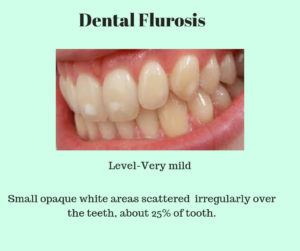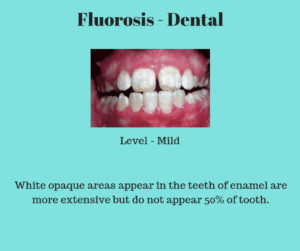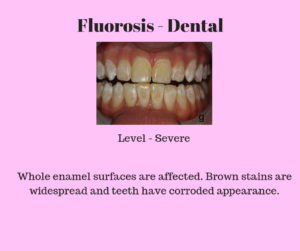Dental Fluorosis

Fluorosis is a disease resulted from the deposition of fluorides in the hard as well as soft tissues of the body. It is a health problem caused by the intake of fluoride through water/food over a long period. It results in health disorders like dental fluorosis, skeletal fluorosis. This is a cosmetic condition that affects teeth and is caused by overexposure to fluoride. Teeth affected by fluorosis appears mildly discoloured. As a result, there may be lacy white markings which only dentists can detect. In severe cases, teeth may have:
- Stains whose colour ranges from yellow to dark brown.
- There may be surface irregularities.
- Pits that are noticeable
The major cause of fluorosis is due to inappropriate use of fluoride-containing dental products. Probably, using a higher amount of fluoride during childhood can cause it.
Other Risks Factors
- Intake of certain drugs such as fluoroquinolone antibiotics, anti-depressants, steroids and anti-inflammatory drugs.
- Fluoridated beverages, toothpaste.
 Dental Fluorosis Symptoms
Dental Fluorosis Symptoms
- Very mild: Opaque paper-white areas are scattered over small areas of the tooth.
- Mild: Opaque areas on the surface are extensive but affected less than 50% of the surface.
- Moderate: White opaque areas affects more than 50% of enamel.
- Severe: Whole enamel surfaces are affected.
Fluorosis Treatments
If dental fluorosis is mild then there is no need for any treatments or if it is affected in back teeth then it can’t be seen. Therefore, teeth affected by the fluorosis can be improved by a variety of techniques. Most of the teeth are aimed at masking the stains.
Techniques
- Tooth whitening to remove the surface stains.
- The bonding that coats the tooth with a hard resin that bonds to the enamel,
- Crowns
- Veneers – custom-made shells that cover the front of teeth to enhance the appearance.
Prevention Of Dental Fluorosis
Fluorosis can be prevented by avoiding the excessive intake of fluoride by the individuals. Likewise, excessive fluoride intake can be prevented or minimized by adopting the following measures:
can be prevented or minimized by adopting the following measures:
- Use alternative water sources.
- Removing excessive fluoride from drinking water.
- Improve or enhance the nutritional status of the population.
- Use alternative water resources
- Surface water: Use surface water after proper disinfection with simple and low-cost methods.
- Rainwater: It is cleaner and simple source and the problem exists for the large reservoir in households.
- Low fluoride groundwater: Fluoride content varies depending on the geological structure. Fluoride is unevenly distributed in groundwater so we need to be very much aware while using groundwater.
- Removing fluoride from drinking water
 Excess fluoride from water can be removed using:
Excess fluoride from water can be removed using:
- Chemical precipitation
- Alum coagulation: Here, raw water is mixed with aluminium sulphate or sodium carbonate and bleaching water.
- Electrolyte defluoridation: In the process, direct current is passed via aluminium electrodes in water, species of a hydroxide of aluminium produced absorbs fluoride ions in water.
- Adsorption: This approach is to filter water through a column packed with adsorbent like activated alumina, activated charcoal or ion exchange resins.
- Ionic separation: The process includes electrodialysis and reverses osmosis filtration.
- Better nutrition
To improve the nutritional status of the affected population are a supplement to the solution that is mentioned above. Therefore mothers of newborn babies need to provide breast milk that is low in fluoride.
Procedures That Do Not Remove Fluoride:
- Boiling water: Boiling the water will concentrate fluoride content.

- Freezing water: Freezing the water will not have any effect on the concentration of fluoride.
- Activated carbon: Usually filters will not remove fluorides.
Providing Health Education
- Similarly, create awareness of the common people on drinking safe water and importance of intake of healthy diet.
- Water with fluoride content that has more than 1ppm should not be consumed.
- Hence intake the foods that are rich in calcium, iron, vitamin c and other oxidants.

Leave a reply